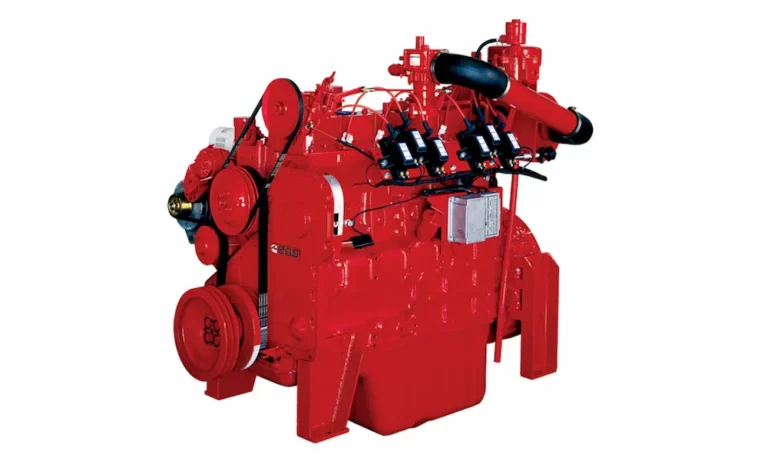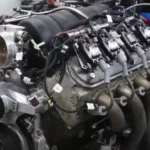Looking for reliable information about the legendary 8.3 Cummins engine? Whether you’re maintaining a commercial vessel, considering a motorhome upgrade, or just fascinated by this workhorse powerplant, you’ve come to the right place. This guide breaks down everything from basic architecture to performance specs across all applications, giving you the complete picture of what makes this engine tick.
The Core Architecture of the 8.3 Cummins
The 8.3L Cummins starts with robust fundamentals that haven’t changed much over its production life. Here’s what makes up the backbone of this trusted engine:
- Inline 6-cylinder configuration
- 8.3 liters (505 cubic inches) of displacement
- 114 mm (4.49 inches) bore
- 135 mm (5.32 inches) stroke
- Heavy-duty cast-iron block with structural reinforcement
- Mid-stop wet cylinder liners that reduce cavitation
- 12-valve design with single-piece crossflow cylinder head
- Counterclockwise rotation when viewed from flywheel end
This architecture provides the perfect foundation for an engine that’s known for both power and longevity. The cast-iron construction might seem old-school, but it’s been specifically reinforced to resist bending and torsion, making it quieter and more durable than many competitors.
The mid-stop wet liners are particularly clever. They not only reduce cavitation (a common issue in hard-working engines) but also improve rebuildability, extending the engine’s useful life far beyond what you might expect.
Industrial Variants: Workhorses for Heavy Equipment
In the industrial sector, the 6C8.3 variant has built a solid reputation, especially in the Indian market. Here’s what makes it tick:
- Power output: 185-260 hp (138-194 kW)
- Heavy-duty pistons featuring Ni-Resist inserts
- Plateau-honed cylinder liners for perfect geometry
- Holset HX40 wastegated turbocharger
- In-line fuel pump delivering higher injection pressures
The industrial versions are particularly noteworthy for their plateau honing technique, which creates near-perfect cylinder geometry and virtually eliminates oil consumption—a significant advantage for equipment that might run for thousands of hours between major services.
Marine Applications: Power on the Water
When it comes to marine use, the 8.3 Cummins really shines with multiple variants tailored for different vessel types and operating profiles.
QSC-8.3: High-Performance Marine Power
The QSC-8.3 represents the upper end of the marine offerings:
- Max power: 493-500 hp (368-373 kW)
- Peak torque: 1696 Nm (1250 lb-ft) at 1400 RPM
- High-pressure common rail fuel system
- Heat exchanger cooling with seawater
- Emissions compliance with IMO Tier II, EPA Tier 3, and EU Stage IIIA standards
- Dry weight: 918 kg (2025 lbs)
- Dimensions: 1282 mm × 767 mm × 1024 mm (L×W×H)
These specs make it perfect for larger pleasure craft and commercial vessels that need reliable power delivery even in demanding conditions.
6CT/6CTA8.3: The Marine Veteran
With a 25-year track record in tough marine environments, the 6CT (turbocharged) and 6CTA (turbocharged and aftercooled) variants have proven themselves time and again:
- Power range: 164-370 hp (122-276 kW)
- Max torque: 1200 lb-ft (1627 Nm) at 1400 RPM
- Compression ratio: 16.2:1
- Oil capacity: 4.5 gallons (17 liters)
- Mechanical fuel injection via Bosch in-line pump
- Flexible cooling options (keel cooling or heat exchangers)
The 6CTA8.3 450 Diamond variant deserves special mention as it’s become something of a legend in both recreational and commercial marine circles. Its mechanical governor and fuel system provide advantages in remote locations where electronics expertise might be limited.
Transportation Applications: Moving Down the Road
For on-highway applications, particularly in motorhomes and RVs, the ISC variant delivers impressive performance:
- Power range: 330-360 hp (246-268 kW)
- Torque: 1000-1050 lb-ft (1356-1424 Nm)
- Variable Geometry Turbocharger (VG Turbo) technology
- High Pressure Common Rail (HPCR) fuel system
- EPA 2007 certification
- Global availability across multiple markets
The ISC variant’s Variable Geometry Turbocharger is particularly valuable for RV applications, providing enhanced engine response at varying altitudes and under changing load conditions—perfect for cross-country travel through mountains and valleys.
Natural Gas Applications: Alternative Fuel Power
The G8.3 natural gas variant showcases the platform’s versatility:
- Power output: 99-190 hp (74-142 kW)
- Naturally aspirated design
- Impco carburetor for stable operation across all loads
- Available catalyst ratings for rich burn operation
- NSPS emissions compliance capability
- Shares major components with diesel variants
This variant is specifically designed for wellhead compression and artificial lift applications in the oil and gas industry. Despite the fuel difference, it shares many major components with the diesel engines, including block, crank, cam, gears, and liners.
Advanced Technologies Across the Family
Certain technologies appear across the 8.3 Cummins family, though implementation varies by variant and application:
Fuel System Variations
The 8.3 Cummins adapts to different needs with varied fuel delivery systems:
- Mechanical injection with inline pump (marine/industrial)
- High Pressure Common Rail (HPCR) systems (newer variants)
- Natural gas carburetion systems (G8.3)
Each system is optimized for its application, balancing factors like simplicity, maintenance access, emissions control, and performance characteristics.
Cooling System Options
Cooling flexibility is another hallmark of the 8.3 platform:
- Heat exchanger systems with seawater cooling
- Single loop keel cooling options for marine applications
- Optional fan drive for radiator cooling in industrial settings
This adaptability means the engine can be effectively deployed across wildly different operating environments, from desert oil fields to arctic fishing vessels.
Performance Comparison Table
| Variant | Application | Power Range (hp) | Max Torque (lb-ft) | Fuel System | Notable Features |
|---|---|---|---|---|---|
| 6C8.3 | Industrial | 185-260 | N/A | In-line pump | Plateau honing, Ni-Resist pistons |
| QSC-8.3 | Marine | 493-500 | 1250 | HPCR | Heat exchanger cooling, Tier 3 compliant |
| ISC | Motorhome/RV | 330-360 | 1000-1050 | HPCR | VG Turbo, EPA 2007 certified |
| 6CT/6CTA8.3 | Marine | 164-370 | 1200 | Mechanical | 25+ year track record, Diamond Series |
| G8.3 | Gas Compression | 99-190 | N/A | Impco carburetor | Natural gas, NSPS compliant options |
Maintenance Considerations
One of the 8.3 Cummins’ greatest strengths is its serviceability across variants:
- Field-repairable design with replaceable wet liners
- Common parts across different application variants
- Accessible mechanical systems in many variants
- Global parts and service network support
The mid-stop wet cylinder liner design is particularly valuable for maintenance as it allows for cylinder rebuilding without total engine disassembly in many cases.
Typical Applications by Industry
The 8.3 Cummins has found homes in numerous applications thanks to its versatility:
Marine Sector
- Commercial fishing vessels
- Tugboats and workboats
- Pleasure craft and yachts
- Emergency power and fire pumps
Transportation Sector
- Class 8 trucks (older models)
- School buses
- Motorhomes and RVs
- Emergency vehicles
Industrial Applications
- Construction equipment
- Agricultural machinery
- Irrigation pumps
- Mining equipment
Oil and Gas Sector
- Wellhead compression units
- Artificial lift systems
- Generator sets
- Pump drives
Reliability Factors
What makes the 8.3 Cummins so trusted across these applications? Several key factors:
- Overbuilt core components compared to competitors
- Simpler mechanical systems in many variants (fewer failure points)
- Evolutionary rather than revolutionary design changes
- Proven track record across decades of service
The 6CTA8.3 marine variant, for example, has been operating in some of the world’s toughest commercial fishing environments for more than 25 years, proving its mettle in conditions that would break lesser engines.
Emissions Compliance Across Generations
As emission regulations have evolved, so has the 8.3 Cummins:
- Early variants: Minimal emissions equipment
- Mid-generation: Varying levels of compliance (EPA Tier 1-2, Euro III)
- Later variants: More sophisticated controls (EPA 2007, IMO Tier II)
- Natural gas variants: NSPS compliance options
The natural progression of emissions technology has generally meant more complex systems on newer variants, though the natural gas G8.3 offers some compliance advantages in certain applications.
Common Upgrades and Modifications
For those looking to enhance their 8.3 Cummins, several proven upgrades exist:
- Enhanced turbochargers for improved response
- Fuel system modifications for increased power
- Cooling system upgrades for extreme environments
- Exhaust system modifications for marine applications
Many marine users of the 6CTA8.3 have found that even minor exhaust system improvements can yield significant performance gains without compromising reliability.
Historical Development of the 8.3 Cummins
The 8.3L Cummins didn’t appear overnight—it evolved through several key phases:
- Initial development as part of the C Series platform
- Introduction of the 6CT/6CTA variants for workhorse applications
- Development of electronically controlled variants (ISC)
- Introduction of common rail fuel systems
- Integration of emissions technology for regulatory compliance
Throughout this evolution, Cummins maintained the core architecture while adapting to changing requirements, creating a platform with exceptional longevity.
Making the Right 8.3 Cummins Choice
With so many variants available, how do you choose? Consider these factors:
- Application requirements (power, torque, duty cycle)
- Regulatory environment (emissions requirements)
- Support availability in your region
- Budget constraints (initial cost vs. operating cost)
- Preference for mechanical vs. electronic control
For marine applications, the choice often comes down to the 6CTA8.3 for those preferring mechanical simplicity versus the QSC8.3 for those needing higher power output and emissions compliance.
The 8.3 Cummins Legacy
Few engines have maintained their relevance across such diverse applications for as long as the 8.3 Cummins. Its combination of robust design, adaptability, and manufacturer support has created a legacy that continues to power equipment around the world.
From the frozen fishing grounds of Alaska to the scorching oilfields of the Middle East, the 8.3 Cummins continues to prove that sometimes, evolutionary development of a solid foundation beats revolutionary redesign every time.
Whether you’re considering a repower project, maintaining an existing installation, or just appreciating diesel engineering, the 8.3 Cummins represents one of the industry’s most respected platforms—and one that’s likely to keep running for decades to come.




